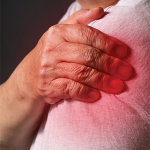Other elements of history include assessment of range of motion. It is easier for patients to comprehend range of motion when assessed as limitations with a functional activity such as reaching for a jar on the top shelf (overhead activities), putting a coat on (for internal rotation), or fastening a bra in females. A history of shoulder instability or clicking suggests a labral or ligament disorder. The author recommends that physicians not familiar with instability refer their patients to a shoulder expert due to potential subtleties in the assessment, diagnosis, and treatment of such patients.
Physical Examination
As described earlier, shoulder pain can often result from a primary nonshoulder-related pathology. In such cases, it is essential to examine the involved region in addition to the shoulder. This article will only focus on musculoskeletal examination of the shoulder. In patients with suspected brachial or other proximal neuropathies, a neurological examination including sensation and reflexes is required.
Inspection: Acromioclavicular separation/deformity, dislocations, and muscle atrophy are visible on inspection of the shoulder. A bilateral comparison should be performed. Muscle atrophy can be assessed by palpation of the muscle bulk as opposed to just visual assessment. Supraspinatus, infraspinatus, and deltoid are the most commonly affected muscles. The examiner may also notice trapezial spasm (elevation of the affected shoulder) that is a common complaint in patients with shoulder disorders.
Palpation: The acromioclavicular joint and the bicipital groove are assessed for localized tenderness. If tenderness is generalized, it is less helpful in localizing the site of pathology.
Range of motion: Ideally, range of motion is measured with a goniometer. In a busy clinical setting, this is difficult to accomplish. Nonetheless, it is important to assess both active and passive range of motion. Both are reduced in adhesive capsulitis and glenohumeral osteoarthritis, whereas only active range of motion is reduced in rotator cuff tears. Range of motion should be assessed for forward flexion, isolated abduction, external and internal rotation with arm at 0º, and external and internal rotation with the arm in abduction. Detailed protocols to measure range of motion are available.4,5
Strength measurement: The author recommends measuring strength using a handheld portable dynamometer as opposed to manual muscle strength testing. Strength should be measured bilaterally for comparison. Strength measurements are performed for abduction, external rotation, and internal rotation. Detailed protocols to measure strength are available.6
Special tests: Special tests are indicated based on clinical judgment of the etiology of shoulder pain. For instance, in patients with adhesive capsulitis, no special tests are required. Moreover, it is not possible to perform special tests in such patients due to pain and limitation in range of motion. In patients with glenohumeral osteoarthritis, special tests may be difficult to perform given the limitation in range of motion but are important to assess whether the patient has a functional rotator cuff.
